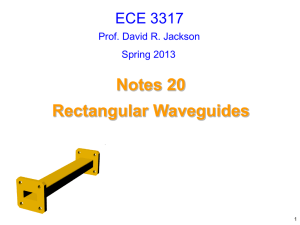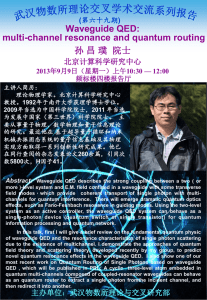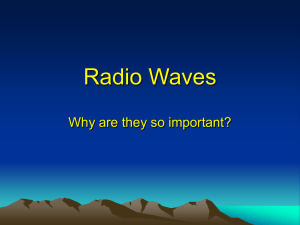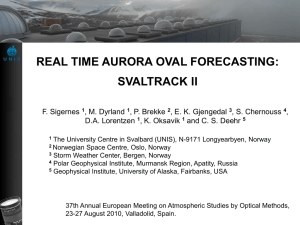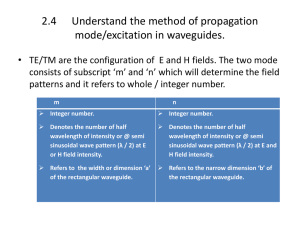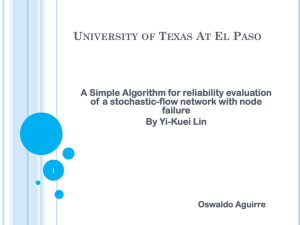Rectangular & Circular Waveguides: TEz & TMz Modes
advertisement
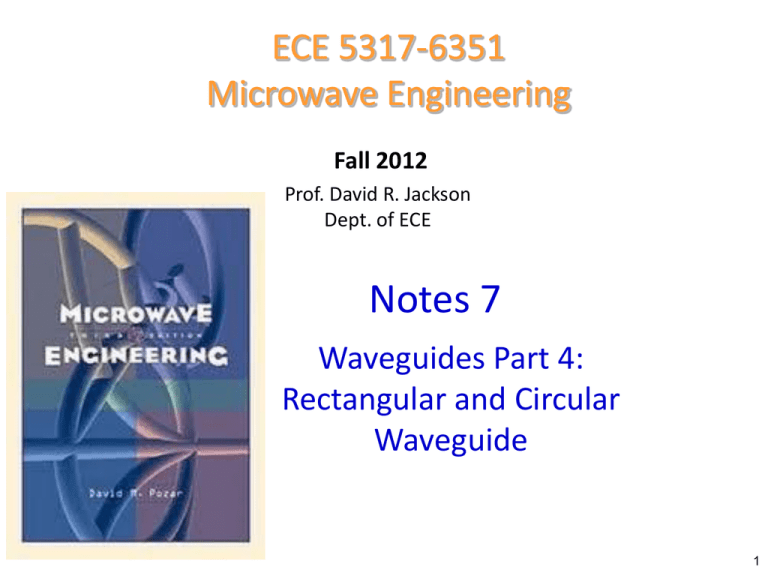
ECE 5317-6351 Microwave Engineering Fall 2012 Prof. David R. Jackson Dept. of ECE Notes 7 Waveguides Part 4: Rectangular and Circular Waveguide 1 Rectangular Waveguide One of the earliest waveguides. Still common for high power and high microwave / millimeter-wave applications. PEC y b , , o z It is essentially an electromagnetic pipe with a rectangular cross-section. Single conductor No TEM mode x o a For convenience a b. the long dimension lies along x. 2 TEz Modes Recall H z x, y, z hz x, y e jk z z b where 2 k c hz x, y 0 2 2 x y 2 PEC y , , 2 o z x o a kc k 2 k z2 1/2 Subject to B.C.’s: and H z Ex 0 y @ y 0, b H z Ey 0 x @ x 0, a 3 TEz Modes (cont.) 2 2 2 h x , y k hz x, y z c 2 2 x y (eigenvalue problem) Using separation of variables, let hz x, y X x Y y d2X d 2Y 2 Y X k c XY 2 2 dx dy Must be a constant 1 d 2 X 1 d 2Y 2 k c X dx 2 Y dy 2 1 d2X 2 k x X dx 2 and where k x2 k y2 kc2 1 d 2Y 2 k y Y dy 2 dispersion relationship 4 TEz Modes (cont.) Hence, X ( x) Y ( y) hz x, y ( A cos k x x B sin k x x)(C cos k y y D sin k y y ) Boundary Conditions: A D0 and B B0 and hz 0 y hz 0 x n ky b m kx a m x n y hz x, y Amn cos cos a b @ y 0, b A @ x 0, a B n 0,1,2,... m 0,1,2,... m n kc2 a b 2 and 2 5 TEz Modes (cont.) Therefore, m H z Amn cos a n x cos b y e jk z z k z k 2 kc2 m n k a b 2 2 2 From the previous field-representation equations, we can show n jk z z x sin y e b j m m n jk z z Ey A sin x cos y e mn 2 kc a a b Ex j n m A cos mn kc2b a jk z m m A sin mn kc2 a a n x cos y e b jk n m n H y z2 Amn cos x sin y e kc b a b Hx jk z z jk z z Note: m = 0,1,2,… n = 0,1,2,… But m = n = 0 is not allowed! (non-physical solution) H zˆ A00e jkz ; H 0 6 TEz Modes (cont.) Lossless Case c k zmn k 2 k mn 2 c m n k2 a b 2 2 TEmn mode is at cutoff when k kcmn f mn c 2 m n 2 a b 1 2 Lowest cutoff frequency is for TE10 mode (a > b) We will revisit this mode. f 10 c 1 2a Dominant TE mode (lowest fc) 7 TEz Modes (cont.) At the cutoff frequency of the TE10 mode (lossless waveguide): f 10 c 1 2a cd cd 10 f fc a f fc cd 1 2a 2a d / 2 For a given operating wavelength (corresponding to f > fc) , the dimension a must be at least this big in order for the TE10 mode to propagate. Example: Air-filled waveguide, f = 10 GHz. We have that a > 3.0 cm/2 = 1.5 cm. 8 TMz Modes Recall PEC y Ez x, y, z ez x, y e jk z z b , , o where z 2 2 2 2 y x 2 e x , y k c ez x, y z Subject to B.C.’s: Ez 0 x o kc k k 2 2 1/2 z a (eigenvalue problem) @ x 0, a @ y 0, b Thus, following same procedure as before, we have the following result: 9 TMz Modes (cont.) X ( x) Y ( y) ez x, y ( A cos k x x B sin k x x)(C cos k y y D sin k y y ) Boundary Conditions: A C 0 and B A0 and m ez Bmn sin a ez 0 n b m kx a ky n x sin y b @ y 0, b A @ x 0, a B n 0,1,2,... m 0,1,2,... m n kc2 a b 2 and 2 10 TMz Modes (cont.) Therefore m Ez Bmn sin a n x sin b y e k z k 2 kc2 jk z z m n k a b 2 2 From the previous field-representation equations, we can show j c n m B sin mn kc2b a n jk z z x cos y e b j c m m n jk z z Hy B cos x sin y e mn 2 kc a a b Hx jk z m m B cos mn kc2 a a n x sin y e b jk n m n E y z2 Bmn sin x cos y e kc b a b Ex m=1,2,3,… n =1,2,3,… jk z z Note: If either m or n is zero, the field becomes a trivial one in the TMz case. jk z z 11 TMz Modes (cont.) Lossless Case c mn k k 2 f cmn mn 2 c m n k2 a b 2 2 m n 2 a b 1 2 (same as for TE modes) 2 Lowest cutoff frequency is for the TM11 mode 2 1 1 f c11 2 a b 1 2 Dominant TM mode (lowest fc) 12 Mode Chart PEC y Two cases are considered: b , , o b < a/2 z x o a a>b Single mode operation TE10 TE 20 TE 01 TE11 TM11 f The maximum band for single mode operation is 2 fc10. ba/2 b > a/2 Single mode operation TE10 TE 01 TE 20 f TE11 TM11 f cmn 2 m n 2 a b 1 2 13 Dominant Mode: TE10 Mode For this mode we have m 1, n 0, kc b , , a o Hence we have H z A10 cos a Hx j Ey PEC y xe z A10 sin a o a jk z z kz a j a x x e A10 sin a E10 xe 2 kz k 2 a jk z z jk z z E y E10 sin a A10 j a xe jk z z E10 Ex Ez H y 0 14 Dispersion Diagram for TE10 Mode Lossless Case c f fc vg slope 2 1 c10 kz k a 2 g 2 (“Light line”) v p slope d Group velocity: vg d Phase velocity: v p Velocities are slopes on the dispersion plot. 15 Field Plots for TE10 Mode PEC y Top view b , , o z z a x x o a E H y y b b a End view x z Side view 16 Field Plots for TE10 Mode (cont.) PEC y b , , Top view o z o a Js x a z x H y y b b a End view x z Side view 17 Power Flow for TE10 Mode Time-average power flow in the z direction: a b 1 * P Re E H zˆ dydx 2 0 0 Note: 10 ab 2x sin dydx 2 a 0 0 a b a b 1 Re E y H x* dydx 2 0 0 a 3 A10 b Re k z 2 4 2 In terms of amplitude of the field amplitude, we have ab 2 P Re k z E10 4 10 A10 j a E10 For a given maximum electric field level (e.g., the breakdown field), the power is increased by increasing the cross-sectional area (ab). 18 Attenuation for TE10 Mode Pl (0) Recall c 2 P0 Pl (0) Rs 2 P0 P10 (calculated on previous slide) PEC y 2 Js d b C J s nˆ H on conductor , , o z Side walls @ x 0 : J sside xˆ H x 0 @ x a : J sside xˆ H ˆ z yA ˆ 10 e jkz z yH x a x o C a H z A10 cos x e jk z z a ka H x j z A10 sin x e jk z z a ˆ z yA ˆ 10 e jkz z yH J syside A10 e jkz z 19 Attenuation for TE10 Mode (cont.) Top and bottom walls @ y 0 : J sbot yˆ H y 0 @ y b : J stop yˆ H b , , y b o J stop J sbot z (since fields of this mode are independent of y) R Pl (0) 2 s 2 b b J side 2 s 0 R dy s 2 a a 0 2 0 2 k z2 a 3 a 2 Rs A10 b 2 2 2 2 x C o a H z A10 cos x e jk z z a ka H x j z A10 sin x e jk z z a 2 J stop dx Rs J syside dy Rs J sxtop J sztop 0 PEC y dx J sztop H x A10 sin x e jkz z a A10 cos x e jk z z a J sztop j J sxtop J sxtop H z kz a 20 Attenuation for TE10 Mode (cont.) Assume f > fc kz (The wavenumber is taken as that of a guide with perfect walls.) PEC y b Pl (0) Rs A10 2 , , 2 a3 a b 2 2 2 o z ab 2 P10 E 10 4 c E10 x o C a j aA10 Simplify, using 2 k 2 kc2 Pl (0) 2 P10 kc10 a Final result: c Rs a 3b k 2 3 2 2 b a k [np/m] 21 Attenuation in dB/m Let z = distance down the guide in meters. c dB/m 20log10 e c z / z c z 20log10 (e) / z Attenuation [dB/m] PEC y b , , o z x o a 8.686 c Hence dB/m = 8.686 [np/m] 22 Attenuation for TE10 Mode (cont.) Brass X-band air-filled waveguide 2.6 10 7 [S/m] X band : 8 12 [GHz] (See the table on the next slide.) 23 Attenuation for TE10 Mode (cont.) Microwave Frequency Bands Letter Designation Frequency range L band 1 to 2 GHz S band 2 to 4 GHz C band 4 to 8 GHz X band 8 to 12 GHz Ku band 12 to 18 GHz K band 18 to 26.5 GHz Ka band 26.5 to 40 GHz Q band 33 to 50 GHz U band 40 to 60 GHz V band 50 to 75 GHz E band 60 to 90 GHz W band 75 to 110 GHz F band 90 to 140 GHz D band 110 to 170 GHz (from Wikipedia) 24 Modes in an X-Band Waveguide a 2.29cm (0.90") b 1.02cm (0.40") Mode TE10 fc [GHz] TE20 13.10 TE01 14.71 Standard X-band waveguide (WR90) X band : 8 12 [GHz] 6.55 TE11 16.10 TM 11 16.10 TE30 19.65 TE21 19.69 TM 21 19.69 1" b a 0.5" 50 mil (0.05”) thickness 25 Example: X-Band Waveguide Determine and g at 10 GHz and 6 GHz for the TE10 mode in an airfilled waveguide. a = 2.29cm 0 , 0 b = 1.02cm @ 10 GHz 2 2 10 2 8 3 10 0.0229 a 2 10 2 158.25 [rad/m] 2 2 g 0.0397 158.25 g 3.97 [cm] 26 Example: X-Band Waveguide (cont.) @ 6 GHz 2 2 6 10 2 k z 8 3 10 0.0 22 9 a j 55.04 [1/m] 2 9 2 55.04 [np/m] g 2 478.08 [dB/m] Evanescent mode: = 0; g is not defined! 27 Circular Waveguide TMz mode: a 2 Ez 0 , kc2 Ez 0 , 0 kz2 k 2 kc2 z The solution in cylindrical coordinates is: J n (kc ) sin(n ) Ez 0 , Yn (kc ) cos(n ) Note: The value n must be an integer to have unique fields. 28 Plot of Bessel Functions 1 1 0.8 J n (0) is finite n=0 0.6 n=1 0.4 Jn (x) n=2 J 0( x) J 1( x) 0.2 J n( 2 x) 0 0.2 0.4 0.403 0.6 0 1 2 3 0 J n ( x) ~ 2 n cos x , x 2 4 4 5 x x x 6 7 8 9 10 10 1 J n ( x) ~ x n n n 0,1, 2,...., x 0 2 n! 29 Plot of Bessel Functions (cont.) 0.521 1 n=0 n=1 0 1 n=2 Yn (0) is infinite 2 Yn (x) Y0( x) Y1( x) 3 Yn( 2 x) 4 5 6 6.206 7 0 0 Yn ( x) ~ 1 2 3 4 5 x 2 n sin x , x x 2 4 6 7 8 9 10 x 10 Y0 ( x) ~ 2 x ln , 0.5772156, x 0 2 n 2 Yn ( x) ~ (n 1)! , n 1, 2,3,....., x 0 x 1 30 Circular Waveguide (cont.) Choose (somewhat arbitrarily) cos(n ) J n ( kc ) Ez , , z cos(n ) e Yn (kc ) jk z z The field should be finite on the z axis Yn (kc ) is not allowed Ez ,, z cos(n ) J n (kc ) e jkz z 31 Circular Waveguide (cont.) B.C.’s: Jn(x) Ez a,, z 0 Hence J n (kc a) 0 Sketch for a typical value of n (n 0). Note: Pozar uses the notation pmn. xn3 xn1 kc a xnp Note: The value xn0 = 0 is not included since this would yield a trivial solution: x xn2 kc xnp a J n xn 0 J n 0 0 a This is true unless n = 0, in which case we cannot have p = 0. 32 Circular Waveguide (cont.) TMnp mode: Ez , , z cos(n ) J n xnp e a xnp 2 kz k a jk z z n 0,1, 2 2 p 1, 2,3,......... 33 Cutoff Frequency: TMz kz2 k 2 kc2 At f = fc : k kc kz 0 2 f c fc TM xnp a xnp a cd xnp 2 a cd c r 34 Cutoff Frequency: TMz (cont.) xnp values p\n 0 1 2 3 4 5 1 2.405 3.832 5.136 6.380 7.588 8.771 2 5.520 7.016 8.417 9.761 11.065 12.339 3 8.654 10.173 11.620 13.015 14.372 4 11.792 13.324 14.796 TM01, TM11, TM21, TM02, …….. 35 TEz Modes Proceeding as before, we now have that H z ,, z cos(n ) J n (kc ) e Set jkz z E a,, z 0 E j H z kc2 (From Ampere’s law) H z 0 a Hence J n (kc a) 0 36 TEz Modes (cont.) J n (kc a) 0 Jn' (x) Sketch for a typical value of n (n 1). x'n3 x'n1 x x'n2 kc a xnp kc xnp a p 1, 2,3,..... We don’t need to consider p = 0; this is explained on the next slide. 37 TEz Modes (cont.) H z , , z cos(n ) J n xnp e a Note: If p = 0 We then have, for p = 0: jk z z 0 xnp n0 J n xnp J n 0 0 a n0 J 0 xnp J 0 0 1 a H zˆ e jkz z p 1, 2, zˆ e jkz (trivial solution) (nonphysical solution) (The TE00 mode is not physical.) 38 Cutoff Frequency: TEz kz2 k 2 kc2 kz 0 kc k 2 f c Hence fc TE xnp a xnp a cd xnp 2 a cd c r 39 Cutoff Frequency: TEz x´np values p\n 0 1 2 3 4 5 1 3.832 1.841 3.054 4.201 5.317 5.416 2 7.016 5.331 6.706 8.015 9.282 10.520 3 10.173 8.536 9.969 11.346 12.682 13.987 4 13.324 11.706 13.170 TE11, TE21, TE01, TE31, …….. 40 TE11 Mode The dominant mode of circular waveguide is the TE11 mode. Electric field Magnetic field (From Wikipedia) TE10 mode of rectangular waveguide TE11 mode of circular waveguide The mode can be thought of as an evolution of the TE10 mode of rectangular waveguide as the boundary changes shape. 41 TE01 Mode The TE01 mode has the unusual property that the conductor attenuation decreases with frequency. (With most waveguide modes, the conductor attenuation increases with frequency.) The TE01 mode was studied extensively as a candidate for longrange communications – but eventually fiber-optic cables became available with even lower loss. It is still useful for some high-power applications. 42 TE01 Mode (cont.) c TE11 TM01 TE21 Pl (0) c 2 P0 TM11 P0 = 0 at cutoff TE01 fc, TE11 fc, TM01 fc, TE21 fc, TE01 f 43 TE01 Mode (cont.) Practical Note: The TE01 mode has only an azimuthal ( -directed) surface current on the wall of the waveguide. Therefore, it can be supported by a set of conducting rings, while the lower modes (TE11 ,TM01, TE21, TM11) will not propagate on such a structure. (A helical spring will also work fine.) 44 TE01 Mode (cont.) From the beginning, the most obvious application of waveguides had been as a communications medium. It had been determined by both Schelkunoff and Mead, independently, in July 1933, that an axially symmetric electric wave (TE01) in circular waveguide would have an attenuation factor that decreased with increasing frequency [44]. This unique characteristic was believed to offer a great potential for wide-band, multichannel systems, and for many years to come the development of such a system was a major focus of work within the waveguide group at BTL. It is important to note, however, that the use of waveguide as a long transmission line never did prove to be practical, and Southworth eventually began to realize that the role of waveguide would be somewhat different than originally expected. In a memorandum dated October 23, 1939, he concluded that microwave radio with highly directive antennas was to be preferred to long transmission lines. "Thus," he wrote, “we come to the conclusion that the hollow, cylindrical conductor is to be valued primarily as a new circuit element, but not yet as a new type of toll cable” [45]. It was as a circuit element in military radar that waveguide technology was to find its first major application and to receive an enormous stimulus to both practical and theoretical advance. K. S. Packard, “The Origins of Waveguide: A Case of Multiple Rediscovery,” IEEE Trans. MTT, pp. 961-969, Sept. 1984. 45
